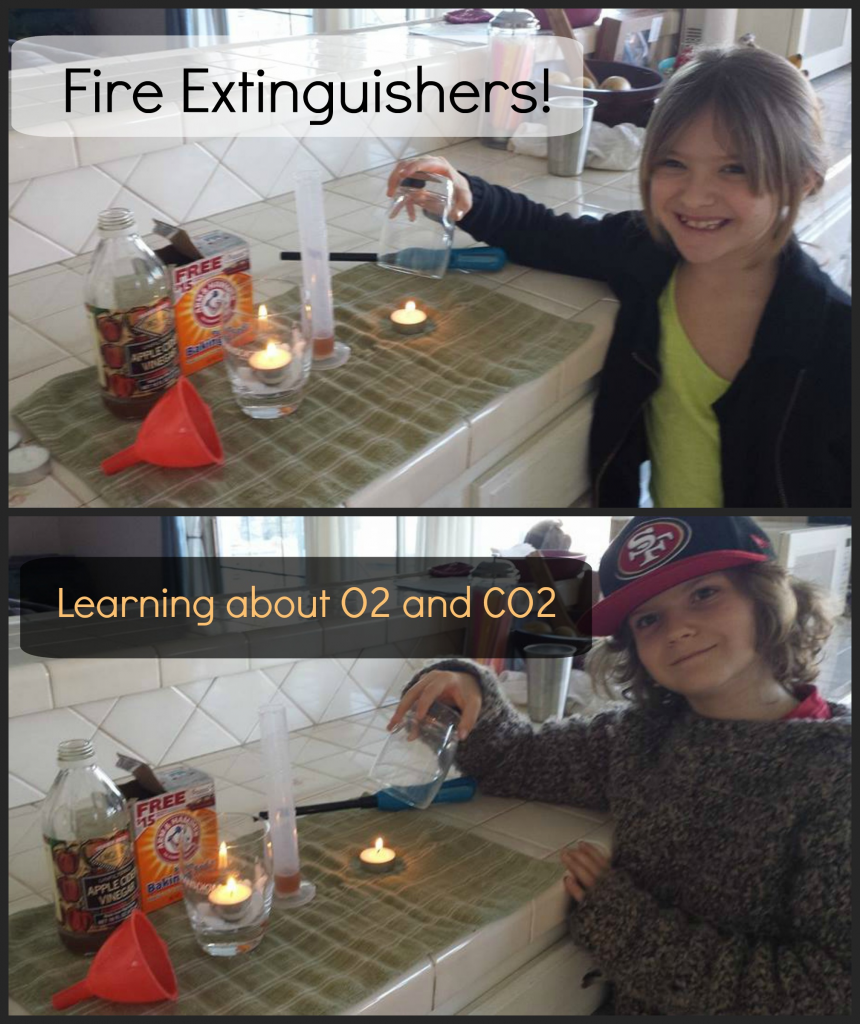
This is our first full week back to homeschool after the holiday break and I have decided to make it a science filled learning adventure! Today we learned about oxygen (O2) and carbon dioxide (CO2) by attempting to make an at home fire extinguisher.
First we got our materials ready:
baking soda
apple cider vinegar (any vinegar will do)
two small glasses
two measuring devices (we used graduated cylinders like these)
small funnel (we needed it to pour the baking soda into our glasses and graduated cylinder, but you could use a teaspoon)
kitchen towel or a small tray
flame igniter or long matches
paper towels (for clean up)
The first experiment that we tried was to extinguish the flame of the candle with the glass. We lit the tea light and then my daughter picked up the glass and placed the glass over the candle. Within a few seconds the flame extinguished and smoke filled the glass. We discussed that the flame needs oxygen, O2, to stay lit. By placing the glass over the candle we limited the amount of O2 that the flame had to use as fuel. Once all of the O2 in the glass was used by the flame the flame no longer had fuel and it went out.
The second experiment that we tried was to create a fire extinguisher by pouring carbon dioxide over the flame. This experiment did not work as planned because we could not start pouring the CO2 (created by baking soda and vinegar in a graduated cylinder) fast enough. So we went on to experiment 3.
For experiment three we measured out equal portions of baking soda and vinegar in our graduated cylinders. Then we placed a tea light candle inside the small glass on top of the vinegar bottle cap. We carefully used the funnel to pour the baking soda all around the candle. (We placed the candle on the cap for additional height.) Then we carefully poured in a small amount of the vinegar until the bubbles rose but did not cover the top of the candle. (We were careful to not pour the vinegar onto the candle flame.) We watched as the flame was extinguished by the CO2. CO2 is heavier than air so the CO2 took the place of the air at the bottom of the glass where the candle flame was therefore replacing the air/fuel for the candle flame and it extinguished the flame. We then tried to relight the candle with our flame lighter and could not. The flame would not ignite because we had the tip of the flame lighter in the area of the glass where the CO2 was filling the glass. We then disturbed the CO2 by blowing air into the glass. We tried to ignite the candle once more and were successful because we had now pushed he CO2 out of the glass and replaced it with air again, therefore providing fuel for our flame.
What did we learn?
-Air and all gasses take up space
-CO2 is created when you mix baking soda and vinegar
-CO2 is heavier than air
-Flames need oxygen
-CO2 extinguished flames
After these experiments were complete my children came up with all kinds of additional experiments they would like to try to get the CO2 to pour onto the flame using tubes and tape. I love how these kitchen materials were able to be used in a great way to spark learning and ‘ignite’ the flames of inspiration in my children! I LOVE homeschool!
